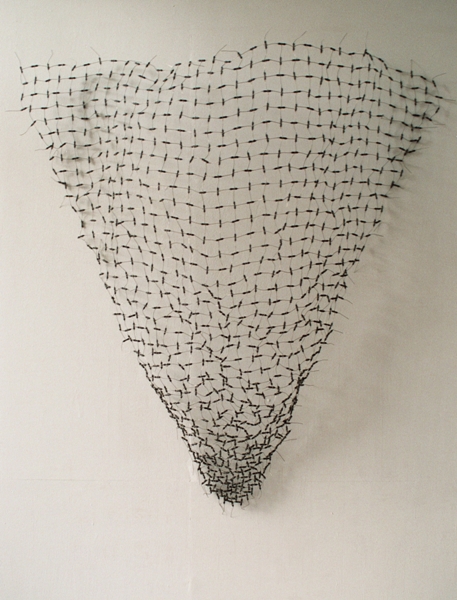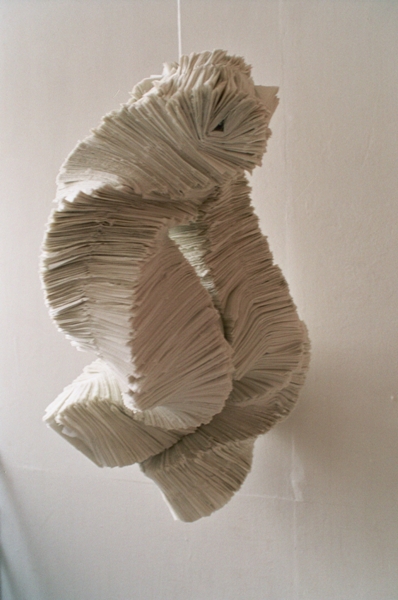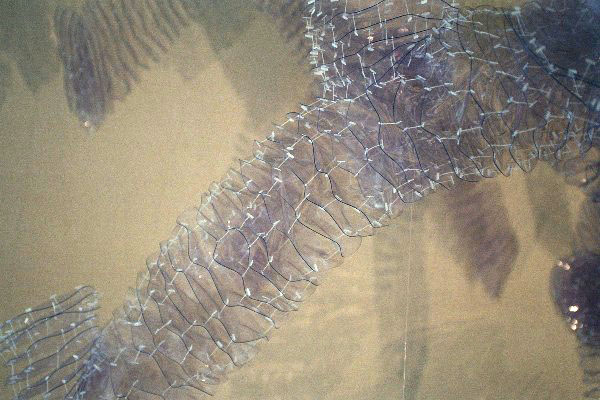Helma Kuijper
Freelance artist
"My ideas for my work arise from my search for individual space and borders. To give these ideas shape, I am looking for an associative way of work and materials. Images are made by making changes in the original materials and yet maintaining their own form, but are looked upon with a different view, separated from its original context. In my installations, I use a multitude of techniques and material (textile, ceramic, plastic, resistances, tape, bamboo, price tags, etc.) for conceptual approaches. Themes centre on human emotions and relations. I am indirectly inspired by mathematical methods that describe conceptual processes: evolution and growth of structures and fluids, contraction of Cartesian coordinate systems, parallelisms. Furthermore, concepts of (computer) vision and graphics are used, like representation of objects using minimal building blocks like ribs or combining 2D and 1D elements to create 3D objects. For more details, see http://www.ricam.oeaw.ac.at/people/page/kuijper/helma/ and http://www.helmakuijper.nl/index_eng.html "
“'Topology of resistance' ”
2004, Resistances, about 36x24 inches
The elements of this work are resistances. In equilibrium, they form a regular square pattern - a Cartesian grid. Due to forces - and different lengths of the resistances - the squares are deformed. Such deformations are used to describe the change of one image into another, which is explained in more detail in submission 27 of Bridges, "Imaging, Mathematics, and Art", by Arjan Kuijper and Helma Kuijper. Depending on designating centres of gravity, one obtains singularities, waves, folding of the manifolds (to be thought of as the set of area patches bounded by the resistance grid), etc.
“ Swan love ”
2006, Paper napkins, about 25x12x14 inch

This work is inspired by the concept of a double helix. It is also a model for a basic structure of life, as discovered by the Nobel laureates Watson and Crick. Each stack of paper serviettes is subject to a horizontal force causing it to rotate along its axis. However, both stacks maintain connected at the top and bottom.
“The worm of consciousness”
2003, Pipe cleaners, round, about 26 inches

Within a 2D circular domain points start to grow into the 3rd dimension, forming curves. These curves can develop freely, but are pair-wise connected (close-up at http://www.ricam.oeaw.ac.at/people/page/kuijper/helma/). This relates to the movement of critical points of an image in Gaussian scale space (explained in more detail in submission 27 of Bridges, "Imaging, Mathematics, and Art", by Arjan Kuijper and Helma Kuijper). They form curves in the scale dimension and are connected pair-wise (a curve of an extremum with one of a saddle point) in catastrophe points.
“ Tie in with ”
2007, Tie ribs, About 14x11x8 inches

Description of Submission #4., focusing on the math content (100 words maximum) 3D objects can be represented as volumes, 2D (closed) surfaces covering the volume, or 1D "ribs" bounding the surfaces. Here we created the illusion of a volume by building ribs of plastic tie ribs. The visual perception of a real object is enhanced by carefully selecting black and white binders and background colour. Since the tie ribs are non-static, the object contains some degrees of freedom to deform, creating a 4D object.
“ Delphinum ”
2008, Plastic tags to connect price labels to - say - clothes, About 36x27x8 inches
("coming out of the wall")

In addition to submission #4, 3D objects can also be constructed in a 2+1D fashion, by connection two subsequent areas by ribs. There the transparent plastic areas are connected by price tag links, allowing the final shape to be flexible. An illusion is created of a viscous fluid without visible boundaries. The direction of the flow is determined by external forces. A large full-size example of such a flow is visible at http://www.ricam.oeaw.ac.at/people/page/kuijper/helma/